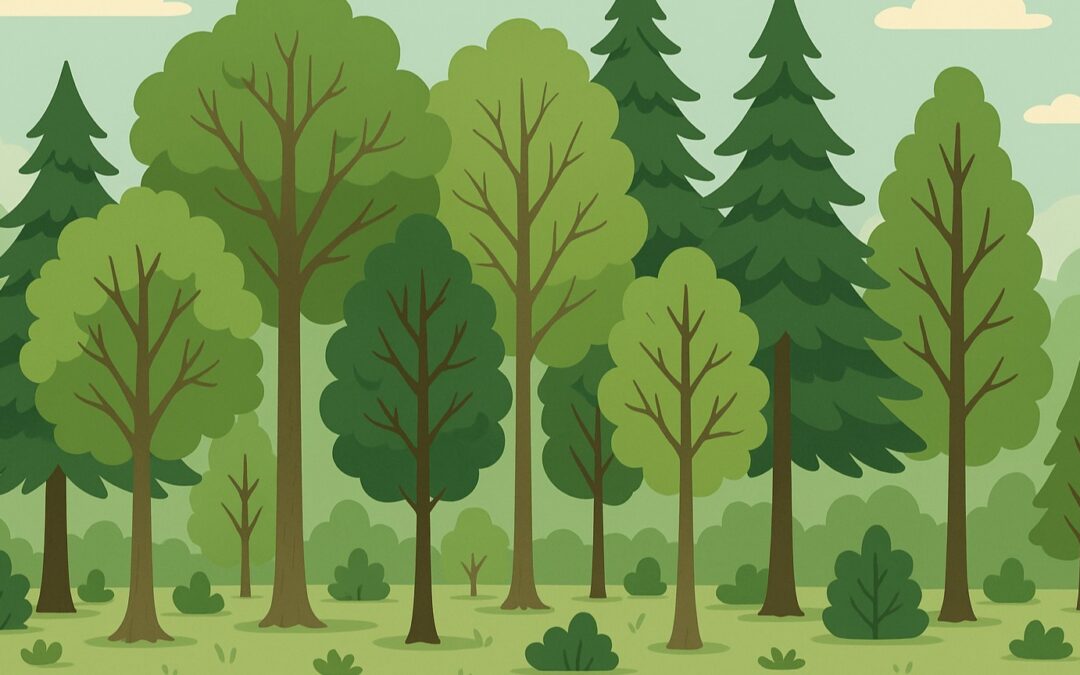You probably didn’t know that forests have long been painted, marked, and modified by people attempting to manage tree growth and biodiversity. But today, thanks to new technology and modelling, there’s a smarter way to do it—by arranging trees with purpose.
Tree planting has historically focused on species selection and planting density. But modern research highlights another important variable: tree species arrangement. The spatial layout of trees—how different species are positioned within a forest—can significantly affect how ecosystems function, including tree growth, nutrient cycling, and carbon storage.
The Role of Spatial Design in Forest Ecosystems
While it’s widely known that diverse forests tend to be more productive and resilient, the spatial configuration of those diverse species has only recently begun to receive scientific attention. When different tree species are mixed strategically, they can enhance each other’s growth through complementary use of light, water, and nutrients. This effect is not just dependent on which species are included, but also on how they are arranged on the landscape.
Simulations using real-world data now show that random or semi-random planting patterns tend to improve biomass production and decomposition rates compared to traditional block planting designs. These findings suggest that not only diversity but the distribution of that diversity matters for overall forest function.
Random Planting Shows Measurable Benefits
In trials simulating forests with varying planting designs, random arrangements of different tree species consistently outperformed more structured layouts. These randomly mixed forests showed an increase in total biomass and more effective nutrient recycling processes, particularly for nitrogen and carbon.
Why does randomness help? In naturally structured environments, fallen leaves and plant litter are more evenly distributed when tree species are intermixed. This promotes more uniform decomposition, improving soil structure and increasing nutrient availability across the forest floor. These conditions lead to enhanced microbial activity and better growth conditions for all species involved.
Line Planting as a Practical Alternative
Although random mixing of species yields the highest ecological performance, it can complicate forest operations like thinning, pruning, and harvesting. For managers who need a balance between ecological benefit and operational efficiency, alternating rows—or line planting—can offer a middle ground. This method involves arranging species in interchanging lines, allowing easier machinery access while maintaining many of the benefits of species mixing.
In simulations, line planting supported higher decomposition rates than block planting, though not quite as high as fully random arrangements. However, it still provided a significant ecological boost while maintaining a structure that is easier to manage in forestry operations.
Diversity Remains the Cornerstone
Beyond how trees are arranged, the number of different species in a forest continues to play a major role in ecosystem health. More species mean a wider range of traits, from root structure to canopy coverage, creating a richer habitat for decomposers and other forest life. This diversity feeds into stronger nutrient cycles and better resilience against pests and environmental stressors.
Interestingly, even forests with relatively simple layouts can benefit from increased species richness. Whether trees are planted in lines or scattered randomly, adding more species generally leads to better performance in terms of productivity and carbon storage.
Applications for Climate-Smart Forestry
Understanding the effects of tree species arrangement is especially relevant in the face of climate change and rising demand for reforestation. As tree planting initiatives grow globally, including large-scale carbon offset programs and national reforestation efforts, choosing the right combination of species and spatial design becomes critical for long-term success.
By integrating models of spatial design with empirical field data, forest planners can better predict outcomes for different planting strategies. This allows for more informed decisions that balance ecological health, carbon storage, and practical considerations in forestry.
More Than Just Where Trees Grow
Forests are not just a collection of trees—they are complex systems where every root, leaf, and interaction plays a role. As research continues to reveal, how we arrange those trees can change everything from how fast they grow to how much carbon they store. Whether aiming to restore degraded lands, create sustainable timber resources, or fight climate change, spatial planning may be just as important as species choice.
In the years ahead, combining digital modelling, field studies, and long-term monitoring will help refine best practices for planting forests that are not only productive but also ecologically resilient. With a better understanding of how spatial diversity shapes ecosystem services, forest managers can plant with both nature and the future in mind.
Branching into Smarter Forestry
The way forward may not be to plant more trees blindly—but to plant smarter. Tree species arrangement, once an overlooked factor, is now emerging as a critical tool in the forest manager’s kit. Whether through randomized planting, strategic line layouts, or enhanced species diversity, the structure of tomorrow’s forests could shape not just our landscapes, but our climate, economy, and environment.
